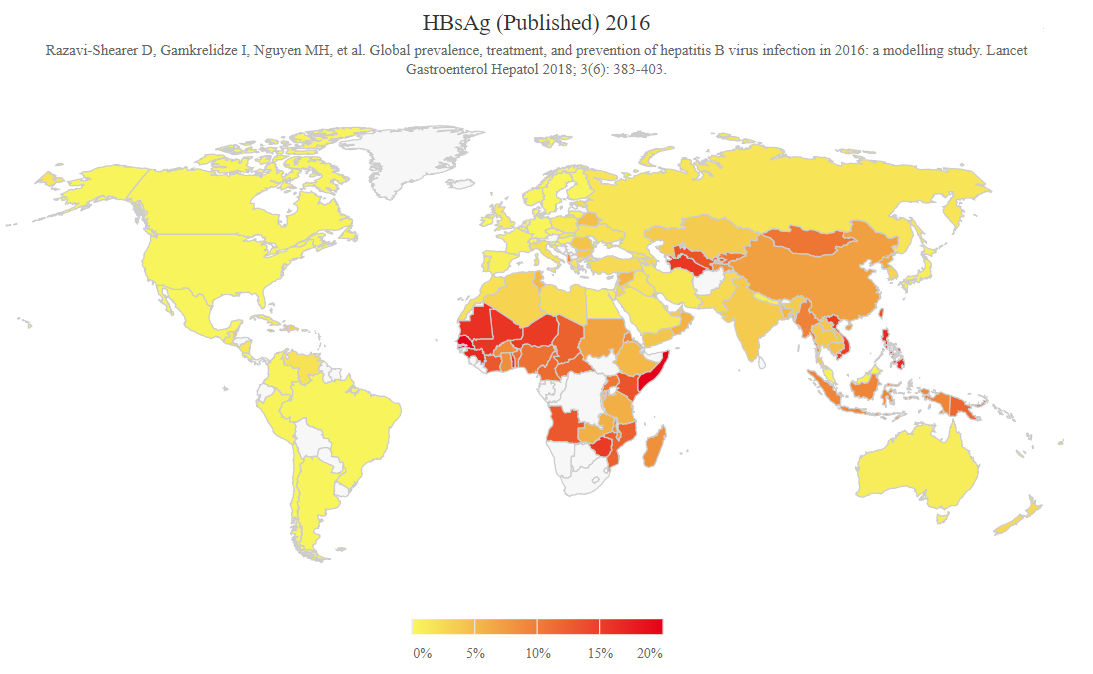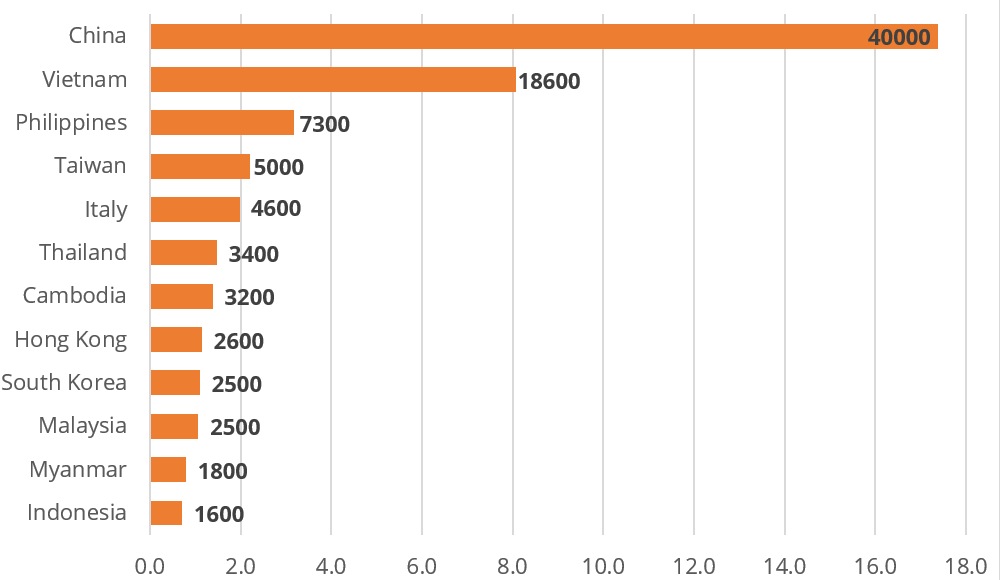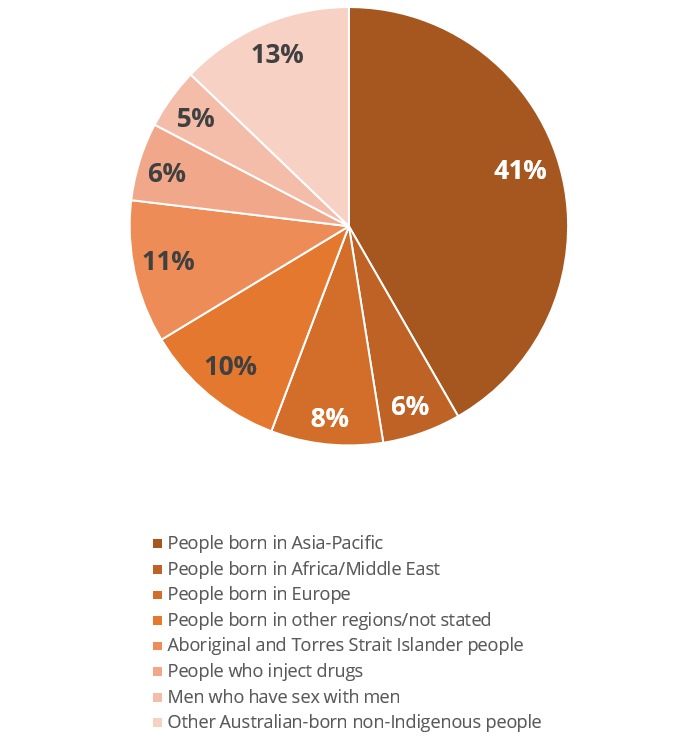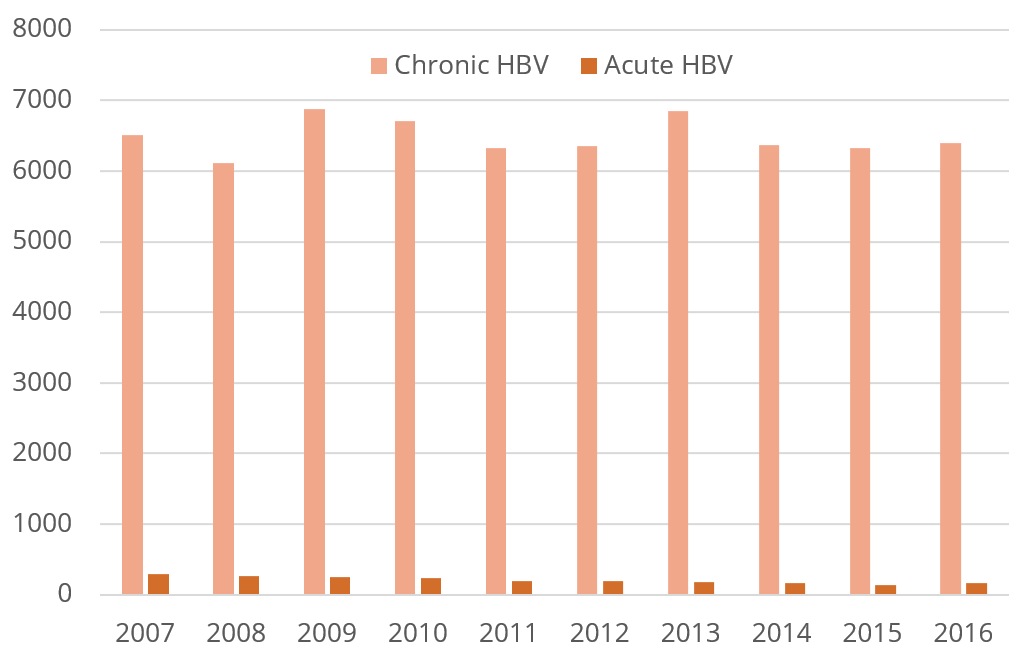KEY POINTS
- In 2016, there were an estimated 230,000 people living with chronic hepatitis B (CHB) infection in Australia, representing 0.9% of the population.
- Only 63% of people living with CHB in Australia are estimated to have been diagnosed.
- Those born overseas and Aboriginal and Torres Strait Islander people comprise around two-thirds of all Australians living with CHB.
- A higher prevalence of CHB infection is also observed in people who inject drugs and in men who have sex with men.
- Over 90% of new cases of CHB in Australia are attributable to migration and cannot be prevented through local vaccination initiatives.
- Deaths due to CHB result from complications of cirrhosis, liver failure and liver cancer (specifically, hepatocellular carcinoma) in up to one-quarter of people living with CHB.
Print as PDF
- Schweitzer A, Horn J, Mikolayczyk R, Krause G, Ott J. Estimation of worldwide prevalence of chronic hepatitis B virus infection: a systematic review of data published between 1965 and 2013. Lancet 2015;386:1546-55.
- WHO. Hepatitis B Key Facts 5 July 2017 Available at: http://www.who.int/news-room/fact-sheets/detail/hepatitis-b (last accessed 17 July 2018)
- GBD Causes of Death Collaborators. Global, regional, and national age-sex specific mortality for 264 causes of death, 1980-2016: a systematic analysis for the Global Burden of Disease Study 2016. Lancet 2017;390:1151-210
- Jemal A, Bray F, Center MM, Ferlay J, Ward E, Forman D. Global cancer statistics. CA Cancer J Clin 2011;61:69-90.
- Lavanchy D. Hepatitis B virus epidemiology, disease burden, treatment, and current and emerging prevention and control measures. J Viral Hepat 2004;11:97–107.
- World Health Organization. Global Hepatitis Report, 2017. Geneva: World Health Organization, 2017.
- Polaris Observatory Collaborators. Global prevalence, treatment, and prevention of hepatitis virus infection in 2016: a modelling study. Lancet Gastroenterol Hepato. 2018;3:383-403. Available at: http://cdafound.org/polaris-hepB-map/ (last accessed 5 July 2018).
- The Kirby Institute. HIV, viral hepatitis and sexually transmissible infections in Australia: Annual Surveillance Report 2017. Sydney: The Kirby Institute, The University of New South Wales; 2017.
- Supramaniam R, O’Connell D, Robotin M, Tracey E, Sitas F. Future cancer trends to be influenced by past and future migration. Aust N Z J Public Health 2008;32:90–2.
- Australasian Society for HIV Medicine and Victorian Infectious Diseases Reference Laboratory. Hepatitis B Mapping Project: Estimates of CHB prevalence and cultural and linguistic diversity by Medicare Local. National Report 2011. Darlinghurst: Australasian Society for HIV Medicine; 2013.
- WHO Collaborating Centre for Viral Hepatitis Epidemiology, Doherty Institute, ASHM. Hepatitis B Mapping Project. Estimates of geographic diversity in chronic hepatitis B prevalence, diagnosis, monitoring and treatment. National Report 2016. ASHM: Darlinghurst; 2018.
- Australian Government. Australian Technical Advisory Group on Immunisation (ATAGI). The Australian Immunisation Handbook. 10th edition (updated 22 June 2015) [internet]. Canberra: Department of Health; 2015. Available at: http://www.immunise.health.gov.au/internet/immunise/publishing.nsf/Content/Handbook10-home~handbook10-updates~handbook10-updates-22-06-2015 (last accessed 24 June 2018).
- MacLachlan JH, Allard N, Towell V, Cowie BC. The burden of chronic hepatitis B virus infection in Australia, 2011. Aust NZ J Public Health 2013;37:416–22.
- Robotin MC, Kansil M, Howard K, George J, Tipper S, Dore GJ, et al. Antiviral therapy for hepatitis B-related liver cancer prevention is more cost-effective than cancer screening. J Hepatol 2009;50:990–8.
- Australian Government Department of Health. Second National Hepatitis B Strategy 2014-2017. Canberra: Australian Government Department of Health; 2014. Available at: www.health.gov.au/internet/main/publishing.nsf/Content/ohp-bbvs-hepb (last accessed 19 June 2018).
- MacLachlan JH, Allard N, Carville KS, Haynes K, Cowie BC. Mapping progress in chronic hepatitis B: geographic variation in prevalence, diagnosis, monitoring and treatment, 2013-15. Aust NZ J Public Health 2018;42:62-8.
- Wong N, Haydon A, Kemp W, Wijeratne P, Roberts S. Improved survival trend of patients with hepatocellular carcinoma at an Australian tertiary hospital between 1995-2009. Intern Med J 2013;43:197–203.
- Carville KS, MacLachlan J, Thursfield V, Cowie B. Hepatocellular carcinoma over three decades in Victoria, Australia: epidemiology, diagnosis, and trends, 1984-2013. Intern Med J 2018 Mar 31. [Epub ahead of print].
- Brown CR, Allard NL, MacLachlan JH, Cowie BC. Deaths from liver cancer continue to rise in Australia: is elimination by 2030 possible? Intern Med J 2017;47:604-5.
- Australian Institute of Health and Welfare. Cancer in Australia 2017. Cancer series no.101. Cat. no. CAN 100. Canberra: AIHW; 2017.
- Hong TP, Gow P, Fink M, Dev A, Roberts S, Nicoll A, et al. Novel population-based study finding higher than reported hepatocellular carcinoma incidence suggests an updated approach is needed. Hepatology 2016;63:1205-12.
- Global Burden of Disease Liver Cancer Collaboration, et al. The burden of primary liver cancer and underlying etiologies from 1990 to 2015 at the global, regional, and national level: results from the Global Burden of Disease Study 2015. JAMA Oncol 2017;3:1683-91.
- Cunningham J, Rumbold AR, Zhang X, Condon JR. Incidence, aetiology, and outcomes of cancer in Indigenous peoples in Australia. Lancet Oncol 2008;9:585–95.
- Parker C, Tong SY, Dempsey K, Condon J, Sharma SK, Chen JW, et al. Hepatocellular carcinoma in Australia's Northern Territory: high incidence and poor outcome. Med J Aust 2014;201:470-4.
- Clark PJ, Stuart KA, Leggett BA, Crawford DH, Boyd P, Fawcett J, et al. Remoteness, race and social disadvantage: disparities in hepatocellular carcinoma incidence and survival in Queensland, Australia. Liver Int 2015;35:2584-94.
- Waziry R, Grebely J, Amin J, Alavi M, Hajarizadeh B, George J, et al. Trends in hepatocellular carcinoma among people with HBV or HCV notification in Australia (2000-2014). J Hepatol 2016;65:1086-93.
- Australian Bureau of Statistics. 2024.0. Census of Population and Housing: Australia revealed, 2016 [internet]. Canberra: Commonwealth of Australia; 2017. Available at: www.abs.gov.au/ausstats/[email protected]/mf/2024.0 (last accessed 20 June 2018).
- MacLachlan JH, Allard N, Carville KS, Haynes K, Cowie BC. Mapping progress in chronic hepatitis B: geographic variation in prevalence, diagnosis, monitoring and treatment, 2013-15. Aust NZ J Public Health 2018;42:62-8.
- Reekie J, Gidding HF, Kaldor JM, Liu B. Country of birth and other factors associated with hepatitis B prevalence in a population with high levels of immigration. J Gastroenterol Hepatol 2013;28:1539-44.
- Cowie B, Karapanagiotidis T, Enriquez A, Kelly H. Markers of hepatitis B virus infection and immunity in Victoria, Australia, 1995 to 2005. Aust N Z J Public Health 2010;34:72–8.
- Deng L, Reekie J, Ward JS, Hayen A, Kaldor JM, Kong M, et al. Trends in the prevalence of hepatitis B infection among women giving birth in New South Wales. Med J Aust 2017;206:301-5.
- Davies J, Li SQ, Tong SY, Baird RW, Beaman M, Higgins G, et al. Establishing contemporary trends in hepatitis B sero-epidemiology in an Indigenous population. PloS One 2017;12:e0184082.
- Reekie J, Kaldor JM, Mak DB, Ward J, Donovan B, Hocking JS, et al. Long-term impact of childhood hepatitis B vaccination programs on prevalence among Aboriginal and non-Aboriginal women giving birth in Western Australia. Vaccine 2018;36:3296-300.
- Harrod ME, Couzos S, Delaney-Thiele D, Dore GJ, Hammond B, Saunders M, et al. Markers of hepatitis B infection and immunity in patients attending Aboriginal Community Controlled Health Services. Med J Aust 2014;201:339-42.
- Carroll E, Page W, Davis JS. Screening for hepatitis B in East Arnhem Land: a high prevalence of chronic infection despite incomplete screening. Intern Med J 2010;40:784–7.
- Australian Government Department of Human Services. Australian Immunisation Register (AIR) statistics [internet]. Available at: www.humanservices.gov.au/corporate/statistical-information-and-data/medicare-statistics/australian-childhood-immunisation?utm_id=9 (last accessed 5 July 2018).
- Dent E, Selvey C, Bell A, Davis J, McDonald M. Incomplete protection against hepatitis B among remote Aboriginal adolescents despite full vaccination in infancy. Commun Dis Intell 2010;34:435–9.
- Wallace J, Pitts M, McNally S, Ward J, Nakata Y, Fagan P. A situational analysis of chronic hepatitis B in the Torres Strait. Monograph Number 82. Melbourne: Australian Research Centre in Sex, Health and Society, La Trobe University; 2011.
- Degenhardt L, Peacock A, Colledge S, Leung J, Grebely J, Vickerman P, et al. Global prevalence of injecting drug use and sociodemographic characteristics and prevalence of HIV, HBV, and HCV in people who inject drugs: a multistage systematic review. Lancet Glob Health 2017;5:e1192-e207.
- Australian Institute of Health and Welfare. National Drug Strategy Household Survey detailed report 2013. Drug statistics series no. 28. Cat. no. PHE 183. Canberra: AIHW; 2014.
- Miller ER, Hellard ME, Bowden S, Bharadwaj M, Aitken CK. Markers and risk factors for HCV, HBV and HIV in a network of injecting drug users in Melbourne, Australia. J Infect 2009;58:375–82.
- Day CA, White B, Dore GJ, van Beek I, Rodgers C, Cunningham P, et al. Hepatitis B virus among injecting drug users in Sydney, Australia: prevalence, vaccination and knowledge of status. Drug Alcohol Depend 2010;108:134–7.
- Gamagedara N, Weerakoon AP, Zou H, Fehler G, Chen MY, Read TR, et al. Cross-sectional study of hepatitis B immunity in MSM between 2002 and 2012. Sex Transm Infect 2014;90:41-5.
- Jin F, Prestage GP, Pell CM, Donovan B, Van de Ven PG, Kippax SC, et al. Hepatitis A and B infection and vaccination in a cohort of homosexual men in Sydney. Sex Health 2004;1:227–37.
- Seib C, Debattista J, Fischer J, Dunne M, Najman JM. Sexually transmissible infections among sex workers and their clients: variation in prevalence between sectors of the industry. Sex Health 2009;6:45–50.
- Butler T, Belcher JM, Champion U, Kenny D, Allerton M, Fasher M. The physical health status of young Australian offenders. Aust N Z J Public Health 2008;32:73–80.
- Richmond J, Smith E, Wallace J, Duncan D, Lucke J. Hepatitis B testing and diagnosis experiences of patients and primary care professionals in Australia. Aust Fam Phys 2017;46(7):513-9.
- Caruana SR, Kelly HA, De Silva SL, Chea L, Nuon S, Saykao P, et al. Knowledge about hepatitis and previous exposure to hepatitis viruses in immigrants and refugees from the Mekong Region. Aust N Z J Public Health 2005;29:64–8.
- Wallace J, McNally S, Richmond J, Hajarizadeh B, Pitts M. Managing chronic hepatitis B: a qualitative study exploring the perspectives of people living with chronic hepatitis B in Australia. BMC Res Notes 2011;4:45.
- Anikeeva O, Bi P, Hiller JE, Ryan P, Roder D, Han G-S. The health status of migrants in Australia: a review. Asia Pac J Public Health 2010;22:159–93.
- Ward J, Bryant J, Worth H, Hull P, Solar S, Bailey S. Use of health services for sexually transmitted and blood-borne viral infections by young Aboriginal people in New South Wales. Aust J Prim Health 2013;19:81–6.




